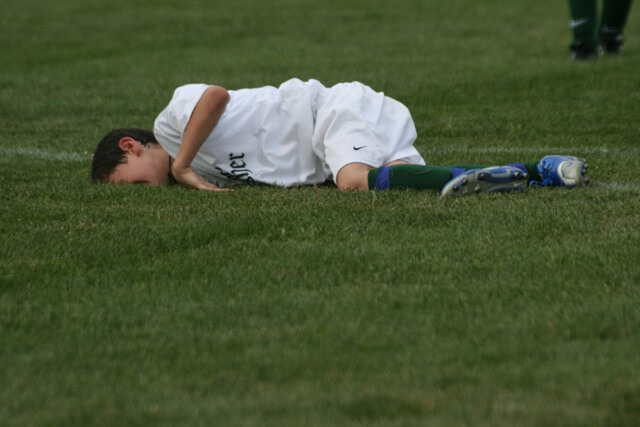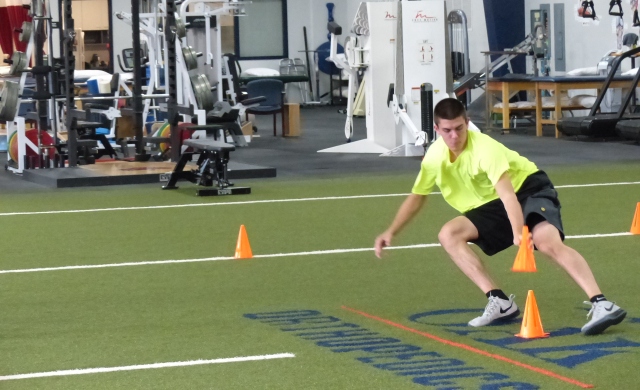We’re back for round two of Why Do Youth Athletes Get Injured? (Part 1) Today we’re talking about the ability to stop. Specifically, an athlete’s ability to decelerate during athletics. As coaches and players all of the hype and publicity is given to an athlete’s speed, or ability to produce force. But realistically, for the majority of athletes out there, their ability to stop and restart is going to have a bigger overall impact on performance and injury prevention. In this article we are going to touch on how poor stopping or deceleration ability leads to more injuries, and ways to improve your athlete’s ability to stop.
First of all, in my direct experience it is an error on a coaches or parent’s part to assume an athlete knows how to stop or even less common, stop well. Yes they can slow themselves down to a stop eventually, but to assume they can efficiently and safely stop going in multiple directions and at high speeds is a massive oversight.

Consider this…
Approximately 70% of ACL injuries are non-contact in nature, meaning there is no direct contact to the knee from another player. These types of injuries are associated with decelerating, pivoting and awkward landings.
Ankle sprains, one of the most common lower body musculoskeletal injuries in athletes most commonly occurs with lateral deceleration or landing.
When the body is not developed enough to control the forces acting on it, injuries occur. In addition, even if the body is strong enough to control these forces, but isn’t in the right position to control these forces, injuries occur.
So this tells us two things…
1) The athlete must be strong enough to decelerate
2) The athlete must have the body awareness and movement skill to put themselves in the right position to control the forces acting on them.
How do we develop these two needs?
#1 Develop yielding strength.
What is yielding strength? Instead of getting hard into the science think of it this way. Yielding strength would be my ability to control my body as I lower into a weighted squat. Yielding strength would be the ability to control myself as I lower into a pushup. Yielding strength would be my ability to control myself when I land from a jump.
So why is yielding strength so important? If I want to make a sharp cut to my left but I’m moving to my right then I will need to quickly lower my center of gravity, take a lateral step with my right foot and drive it as forcefully as possible into the ground. If I do not have adequate strength or force production ability I will not change direction very fast and certainly will not be very explosive reaccelerating. In addition, if I don’t have yielding strength, the momentum already taking me to the right will continue to take me to the right because I lack the ability to control momentum. Or at least lack the ability to quickly control momentum. So I will stop at some point but it will be much slower if I had the ability to “load” the system and explode. Or in other words the hard and fast cut is the action (deceleration) and the foot into the ground (reacceleration) is the reaction. Without an initial high force action the reaction on the opposite end will be equal. Weak and limited.
So yes, an athlete absolutely must be explosive, propulsive, accelerative, and powerful. But before any of that they must be able to absorb, and transfer force. Think of it this way, you want your athlete or player to be explosive, well Newton tells us for every action there is an equal and opposite reaction. This is absolutely critical to understand if you want 1) healthy athletes, 2) athletes that can change direction quickly and have an awesome first step.
How do you train yielding or eccentric strength?
Tempo training. For our junior high athletes we divide their strength programs into 3-phases: green, yellow and red. During the green workouts they have the green light and perform the exercises like, squats, lunges and pushups at regular speed. During the yellow workouts they “yield,” for this we utilize a 5-count slow lowering. So instead of simply dropping into the bottom of a squat they slowly descend into the squat for a full 5-count, focusing on controlling themselves. Once they reach the bottom they accelerate back to the top. During the red workouts they pause or stop at the bottom for a full 5-count. We love this type of training with our young athletes and it helps them really develop stopping strength.
With tempo or yielding strength training the emphasis should be placed on controlling every inch, every second of the entire movement. This will build stopping strength throughout the entire range of motion. This type of training is also great for developing body awareness as it makes the athlete slow down and focus on what they are doing and controlling their entire body while they’re doing it.
In addition to strength training, stopping skill is a major priority during agility or change of direction training. Simple drills which are just focused on stopping in different position are great for building yielding strength as well.
#2 Stopping skill.
As mentioned, assuming athletes know how to put their bodies in the right position to stop well is an oversight. It is something that must be coached, especially at a youth level. We use a simple but highly effective checklist for cuing stopping or deceleration.

1) Stay inside the tunnel- This simply means stay low. We are looking for triple bend (hips, knees, ankles), but none in the back. If the athlete is high, so is their center of gravity which easily predicts they will have poor leverage when it comes to high forces acting on their bodies during stopping and landing.
2) Foot outside the box- We imagine our shoulders and hips make up a box. When we stop the brake foot must step directly outside the box to create an effective braking angle.
3) Foot flat- The brake foot must be flat on the ground. If the any part of the foot is off the ground this limits the ability to completely control momentum and in turn, limits are ability to push back to reaccelerate. In addition, trying to stop on the balls of your feet is a recipe for a rolled ankle.
4) Knees and feet aligned- This one is a big deal. For a large portion of youth athletes knee stability (really hip stability) is a big limiting factor. We commonly see athletes land and stop with knees turned in (valgus), this is a big no-no and is a direct mechanism of ACL injuries. Therefore, we want the knee to be aligned with the middle toe of the foot or even pushed out side of the foot, every time we stop. Whatever it takes, we never want to see the knees buckle, so this must be coached and trained with consistency and with the proper exercise progression.
So putting it all together, stopping, or better put, putting yourself in the best position to reaccelerate is developed by developing the physical capacity to actually control the forces at play and then build the movement skill to utilize the strength in a functional and athletic way yielding high performance and most importantly healthy athletes.

